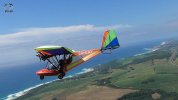This was addressed at length back in February.
Q: And I have a follow-up question. Could you give us an estimate of how big the balloon was? We saw that it had solar panels and it could also potentially had a recording device on it.
GEN. VANHERCK: Yes, so the balloon assessment was up to 200 feet tall for the actual balloon. The payload itself, I would categorize that as a jet airliner type of size, maybe a regional jet such as a ERJ or something like that. Probably weighed in access of a couple thousand pounds. So I would -- from a safety standpoint, picture yourself with large debris weighing hundreds if not thousands of pounds falling out of the sky. That's really what we're kind of talking about.
So glass off of solar panels potentially hazardous material, such as material that is required for batteries to operate in such an environment as this and even the potential for explosives to detonate and destroy the balloon that -- that could have been present.
So I think that would give you an idea of the perspective of the balloon and the decision-making process along the way.
STAFF: Thank you, sir.
Q: Thank you.
STAFF: Let's go to -- let's go to Jennifer Griffin, Fox.
Q: Thanks, General VanHerck. Can I just ask you, on the record again, because there's been a lot made in recent days still about why this was not shot down after it crossed or neared the Aleutian Islands? Can you just explain what you were watching then, what you were thinking then? What the decision-making process was. And why it -- you didn't have enough time to do so, if that was the case?
GEN. VANHERCK: Thanks, Jennifer. It wasn't time. It -- the domain awareness was there as it approached Alaska. It was my assessment that this balloon did not present a physical military threat to North America, this is under my NORAD hat. And therefore, I could not take immediate action because it was not demonstrating hostile act or hostile intent. From there, certainly, provided information on the status of the whereabouts of the balloon. And moving forward, kept the department and the governor -- the government of Canada in the loop as my NORAD, I have a boss in Canada as well. Over.
Q: (inaudible), I'm still having trouble understanding the decision early on. You — you just said seven miles of debris. I mean, there must be parts of the Aleutian Islands and — and Canada that are so — so sparsely populated that there are fewer civilians per square mile than there are off the East Coast of the United States. So was it really just what might happen to people on the ground or was — was it the fact that you weren't ready to take a shot early on?
SENIOR DEFENSE OFFICIAL: I'll say that we were consistently assessing the threat that this ballooned posed. At the point that we thought that it posed a potential threat to us here in the continental United States, we started developing options. And at that point we decided that the risk-reward was not worth taking it down over land. And we waited for it to go over more.
Q: But that — that sounds like it was — it was too late to take a shot by the — by the time you realized it was an intelligence threat to the United States.
SENIOR DEFENSE OFFICIAL: We — we assess that it was not a considerable intelligence threat to the United States, because we don't think the technology on this balloon provided significant value-added over and above what the PRC already had. And we also took additional mitigation steps along the path of the balloon.
So we were constantly assessing the threat that this balloon posed to civil aviation, to anybody on the ground, to the intelligence value. And doing the risk-reward, about whether it was worth bringing this thing down over land, we ultimately decided it was the least risky option to bring it down over the water, and that's what we did successfully today.
STAFF: Thank you.
Ladies and gentlemen, we only have time for a couple more questions. The next question will go to Jennifer Griffin, FOX.
Q: Thanks. I just need — I'm really confused about why not take — I understand why not take it down over land after January 31st, but after January 28th, when it crossed over Alaska, and then it's my understanding it crossed over water again, why not take it down over the water at that time before it entered the continental United States?
SENIOR DEFENSE OFFICIAL: The options presented to us were to take it down over the continental United States or over the water.
Q: So does that suggest you only began — when did you begin tracking this balloon?
SENIOR DEFENSE OFFICIAL: The balloon entered the ADIZ north of the Aleutian Islands on January 28th. It then entered Canadian airspace on January 30th. It entered the continental United States airspace on January 31st, just in northern Idaho. And I would kick it out to our senior military official for any additional operational detail.
SENIOR MILITARY OFFICIAL: Thank you. Jennifer, I would say that it really didn't go back out over the water. Once it entered over Alaska, it stayed over Alaskan physical territory, traversed east across the northern part of Alaska and then into the Northwest Territories in the far northwest portion of Canada before it came back south into the Idaho area.
So there was not really a specific water shot there, opportunity at that point.
Note that of the 3 objects shot down subsequently, 2 were shot down over water as well, and the one that was shot down over land was over a largely uninhabited region of Canada, and it was much smaller.


